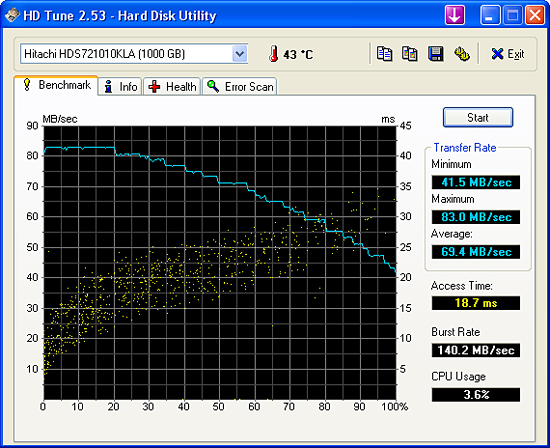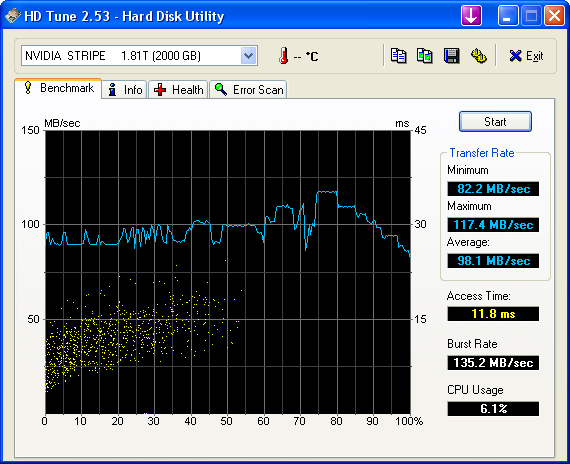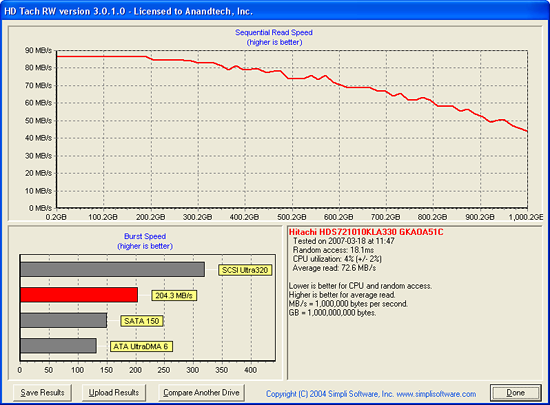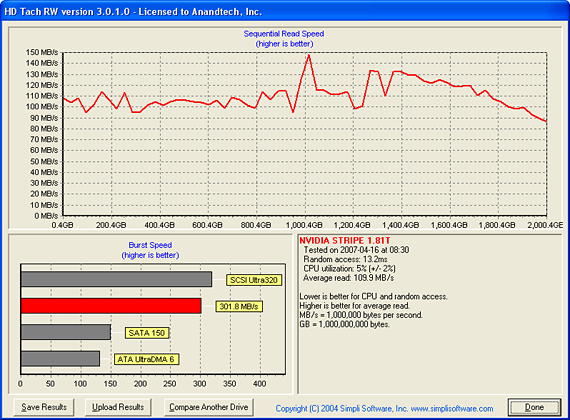Hitachi Deskstar 7K1000 in RAID 0: Is Two Terabytes really better than One?
by Gary Key on April 19, 2007 12:15 AM EST- Posted in
- Storage
Hard Disk Performance: HDTune 2.53



Our first screenshot is the Hitachi drive with Automatic Acoustic Management (AAM) and Native Command Queuing (NCQ) turned on in RAID 0 operation with the second screenshot showing the same configuration with a single drive. The RAID 0 setup shows a 98% increase in the minimum transfer rate and a 41% increase in the average sustained transfer rate. The maximum transfer rate also increases 41% although the burst rate is slightly lower. We believe HD Tune has a bug as the RAID 0 results indicate access times improving slightly when in reality they should not change or perhaps even increase slightly. Our HD Tach results bear this out so we will ignore the reported improvements in RAID 0 access times with this program.
The third screenshot is the RAID 0 results with AAM off and NCQ on. The transfer rates are basically the same with the only difference being a further reduction in access times compared to our first RAID 0 test result. We noticed the same drop in access times when turning off AAM during our single drive testing in the first article. Although the access times are improved we believe the benefits in the acoustics department outweigh the slight performance improvements we noticed in our application tests. We found that enabling AAM usually did not alter the test results more than 1% and at times the scores were a tie.
Hard Disk Performance: HD Tach 3.0



We are also including HD Tach results for review. Once again the order of the screenshots is the same as in our HDTune results. In this benchmark we see a 50% increase in the average read rates and a 52% increase in burst speeds over the single drive configuration with access times remaining the same in the AAM on /NCQ on tests. Our RAID 0 results with AAM off show an improvement in access times and sustained transfer rates while burst rates decline slightly compared to our other RAID 0 test results. While these numbers are impressive, we will have to see if they translate directly to improved application scores.



Our first screenshot is the Hitachi drive with Automatic Acoustic Management (AAM) and Native Command Queuing (NCQ) turned on in RAID 0 operation with the second screenshot showing the same configuration with a single drive. The RAID 0 setup shows a 98% increase in the minimum transfer rate and a 41% increase in the average sustained transfer rate. The maximum transfer rate also increases 41% although the burst rate is slightly lower. We believe HD Tune has a bug as the RAID 0 results indicate access times improving slightly when in reality they should not change or perhaps even increase slightly. Our HD Tach results bear this out so we will ignore the reported improvements in RAID 0 access times with this program.
The third screenshot is the RAID 0 results with AAM off and NCQ on. The transfer rates are basically the same with the only difference being a further reduction in access times compared to our first RAID 0 test result. We noticed the same drop in access times when turning off AAM during our single drive testing in the first article. Although the access times are improved we believe the benefits in the acoustics department outweigh the slight performance improvements we noticed in our application tests. We found that enabling AAM usually did not alter the test results more than 1% and at times the scores were a tie.
Hard Disk Performance: HD Tach 3.0



We are also including HD Tach results for review. Once again the order of the screenshots is the same as in our HDTune results. In this benchmark we see a 50% increase in the average read rates and a 52% increase in burst speeds over the single drive configuration with access times remaining the same in the AAM on /NCQ on tests. Our RAID 0 results with AAM off show an improvement in access times and sustained transfer rates while burst rates decline slightly compared to our other RAID 0 test results. While these numbers are impressive, we will have to see if they translate directly to improved application scores.










48 Comments
View All Comments
Pirks - Thursday, April 19, 2007 - link
call it a waste after you lose a terabyte of data because you hdd died on ya, until then - move alongyyrkoon - Thursday, April 19, 2007 - link
BTW, those of us who are truely serious about their data, do not keep the data stored on HDD alone. Tape, offsite, optical, choose your poison.Pirks - Friday, April 20, 2007 - link
for me number one reason for data loss was ALWAYS hdd failure, those caviars that click to death. I've never experienced data loss for any other reason. hence my natural impulse is to put two hdds in mirror raid - this eliminates most potent threat. and striping only doubles it, plus striping only slows things down when you copy big files (video mux/demux and stuff like that) so for me its mirror only (plus extra drive to speed up file copies a LOT)yyrkoon - Thursday, April 19, 2007 - link
If you are smart about how you use your HDDs, you will have no need, BUT if it makes you feel all warm and fuzzy inside, more power to you. The rest of us, who live in reality, and have HDDs much older than 10 years old, still functional, know better.Pirks - Friday, April 20, 2007 - link
yeah, I have 80 gig wd that I bought I forgot when, 5 years ago? maybe more... it's hot and noisy but looks like it's immortal. however, I wish ALL hdds were like this one. which they are not, unfortunately. those who experienced dead hdds (without doing anything special, just hdd that suddenly dies on you after a couple of years of excellent service) know better than youmlambert890 - Thursday, April 19, 2007 - link
it's not hundreds of dollars, its not insane, and you are wrong. its really kind of amusing that people are "debating" the basic premise of if a stripe set yields better read performance as if this were some new invention newly discovered and untested!Boushh - Thursday, April 19, 2007 - link
Well, maybe not hunderds of dollars (I agree that putting two of these 1 TB drive in RAID 0 is not very usefull) but if you go down the price list you can buy 2 320 Gb drives and put them in RAID 0. They are not expensive, and I know from my own experience that it realy makes a difference. All disk based activity is a lot faster than it would be on a single drive.I've may OS and my games on the RAID 0, and it realy helps speeding things up. So when the price is right RAID 0 is the way to speed up disk activity.
DigitalFreak - Thursday, April 19, 2007 - link
*sigh*mlambert890 - Thursday, April 19, 2007 - link
sigh all you want, but this is not up for debate. Many of us spend all day every day building and operating RAID systems. maybe for you, one article from anand that confirms some weird bias you have is sufficient. for those of us with 20+ years of doing this, the benefits of multiple spindles really dont need to be retested, and reproven, to make yet another generation feel cozy.synthetic benchmarks arent operating in some alternate reality. if whatever you are doing on your pc involves moving large, linear, blocks of data then you will benefit from a throughput boost clearly. in this case, a stripe set will yield quantitative benefit.
for many, loading something (even a game) seconds faster has value. esp since raid 0 has become a complete commodity. pointless article really, and pointless comments from the clueless. raid 0 has been written about and analyzed by smarter poeople with better measurement tools for decades. maybe people should try using common sense and broadening their google searches (that is if collecting their own real world experience is too much trouble)
OrSin - Thursday, April 19, 2007 - link
I got 20 years plus experience working in server farms and Raid is great from 0 to 5.With that said desktop raid dont do crap. I have over 10 systems in my house most on the extra same hardware. I tested Raid 0 and raid 5 and the difference in transfer speed even from GB switchs in less then 8%. Sorry but unless the maps or levels are just sitting in cache it don't do anything. Most of the delay is in seek time and Raid dont improve that at all. In fact I beleive it slows it (no proof). Please with all your experience the desktop and Server space is very different. Also remember SCSI raids improve seek time alot. I think if SATA hardware raids improve then raiding desktop might help.
PS
What are people doing they they even need a 50% improvement in hardrive speed on a desktop? Load levels and map? Sorry but saving even 5 secs out of 10, 5 times a day is not work the extra money to me. CPU, Ram, and Video cards scale so much better. You want the speed make a ram disk. :)